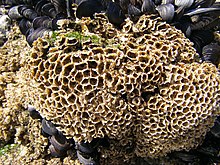Sabellaria alveolata
| Honeycomb worm[1] | |
|---|---|

| |
| Scientific classification | |
| Kingdom: | |
| Phylum: | |
| Class: | |
| Subclass: | |
| Order: | |
| Suborder: | |
| Family: | |
| Genus: | |
| Species: | S. alveolata
|
| Binomial name | |
| Sabellaria alveolata | |
Sabellaria alveolata, (also known as the honeycomb worm), is a reef-forming polychaete. It is distributed around the Mediterranean Sea, and from the north Atlantic Ocean to south Morocco. It is also found in the British Isles at its northern limit in the northeast Atlantic.[2] Its common name is derived from the honeycomb-like pattern it creates when building its tube reefs.
Description

S. alveolata is an annelid (ringed worm) that lives in small tubes it constructs from cemented coarse sand and/or shell material, forming reefs.[2] The tubes are arranged in close proximity and have a distinctive honeycomb-like appearance.[3] These reefs range from 30 centimetres (12 in) to 2 metres (6.6 ft)[4] thick and take the form of hummocks, sheets or more massive formations.[3] Adult size ranges from 30 to 40 millimetres (1.2 to 1.6 in).[2] The thorax has three pairs of flattened chaetal sheaths, its chaetes form an operculum which is used to seal the tube opening.[2] Depending on the local substrate, the colour of the tube varies.[2]
References
- ^ Gérard Bellan (2011). Read G, Fauchald K (eds.). "Sabellaria alveolata (Linnaeus, 1767)". World Polychaeta database. World Register of Marine Species. Retrieved December 6, 2011.
- ^ a b c d e "Honeycomb worm". Grzimek's Animal Life Encyclopedia. Gale. 2003. Retrieved 2009-08-01.
- ^ a b Moffat A (1999). "Action plan for Sabellaria alveolata reefs". United Kingdom Biodiversity Action Plan. Retrieved 2009-08-05.
- ^ Hermelles
